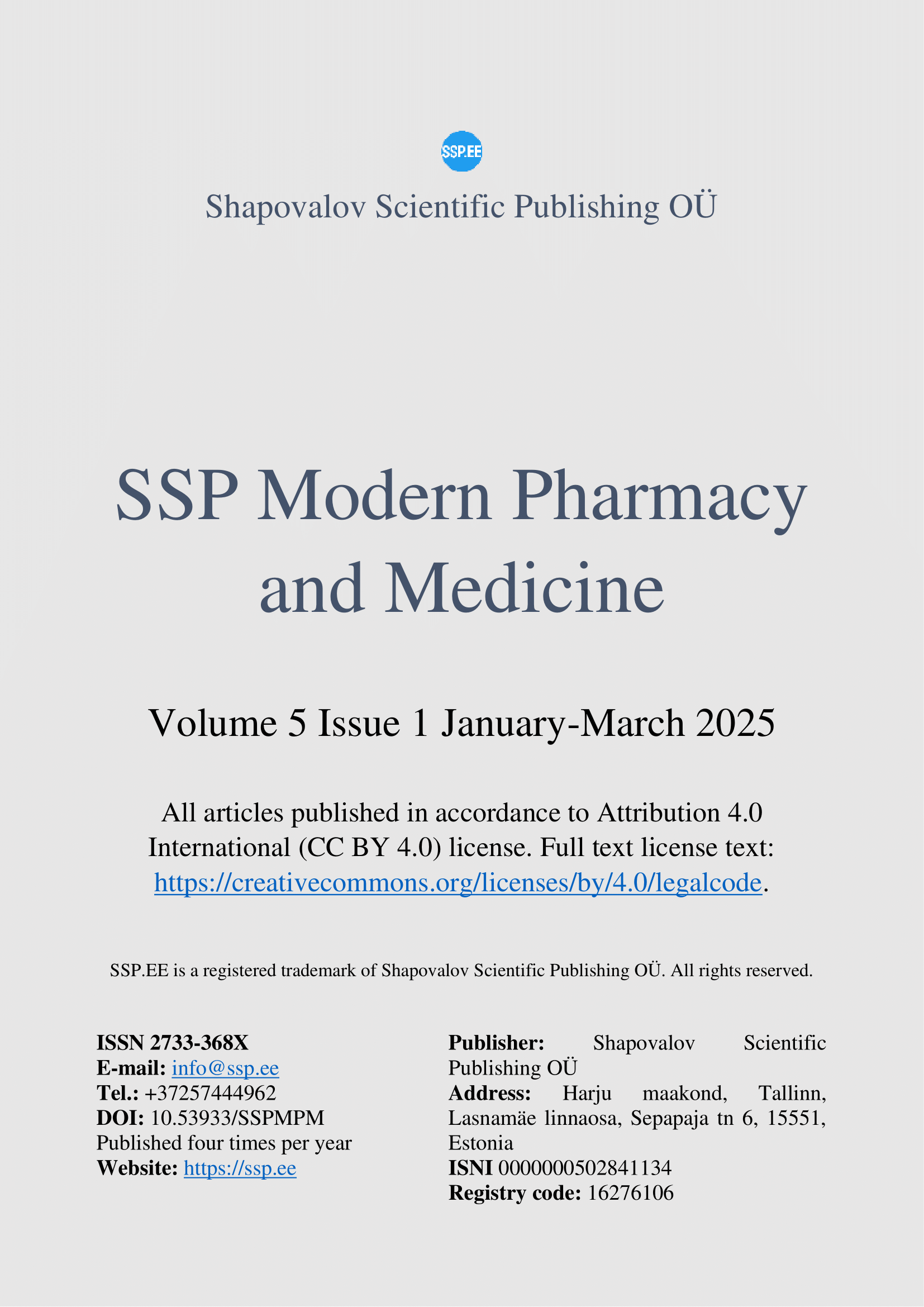Plasma Medicine: Innovative Methods of Diagnosis and Treatment of Chronic Wounds and Oncological Diseases
DOI:
https://doi.org/10.53933/sspmpm.v5i1.174Keywords:
plasma medicine, cold atmospheric plasma, multidrug-resistant pathogens, wound treatment, oncology, sterilizationAbstract
This paper examines the contemporary landscape and future potential of plasma medicine as a transformative branch of healthcare innovation. Centered on the use of cold atmospheric plasma, this emerging field has demonstrated remarkable effectiveness in treating chronic wounds, combating multidrug-resistant pathogens, managing dermatological and oncological conditions, and sterilizing medical instruments and surfaces. Emphasis is placed on understanding the mechanisms of action -especially the generation of reactive oxygen and nitrogen species that selectively target pathogenic microbes and cancer cells. International research findings further affirm the promising integration of plasma technologies into modern medical practice, highlighting both its benefits and challenges, along with its social and economic implications. Moreover, the rapid evolution of plasma medicine is opening new avenues for treatment strategies that may complement existing therapies to improve patient outcomes. Researcher explores innovative combinatory approaches and refining protocols to maximize clinical efficacy, ensuring that this technology can be standardized and broadly applied. These advancements position plasma medicine as a pivotal development in addressing complex global health challenges with safe, effective, and forward-thinking solutions. Ongoing research into plasma medicine is further enhanced by collaborative efforts among scientists, clinicians, and engineers. Their work is refining plasma device technology, standardizing treatment protocols, and deepening the understanding of cellular responses, which is crucial for optimizing therapeutic outcomes and ensuring the safe, widespread adoption of plasma-based interventions globally.
References
Titarenko Y., Shapovalov V. The Latest Quantum and Medical, Quantum and Pharmaceutical Technologies in Countering the Criminal and Legal, Forensic and Pharmaceutical Risks of Circulation of Falsified Drugs. SSP Modern Law and Practice. 2024. Vol.4. No.2. P.1-25. URL: https://doi.org/10.53933/sspmlp.v4i2.149 DOI: https://doi.org/10.53933/sspmlp.v4i2.149
Quantum medicine – treatment using electromagnetic waves. Popular Science Blog "Intellect". 2024. URL: https://www.npblog.com.ua/meditsina/235-kvantova-meditsina-likuvannja-za-dopomogoju-elektromagnitnih-hvil.html
Bisiani J., Anugu A., Pentyala S. It’s time to go quantum in medicine. Journal of Clinical Medicine. 2023. Vol.12. No.13. P.e4506. URL: https://doi.org/10.3390/jcm12134506 DOI: https://doi.org/10.3390/jcm12134506
Song S., She Z. (2022) . Quantum theory-based physical model of the human body in TCM. Digital Chinese Medicine. 2022. Vol.5. No.4. P.354-359. URL: https://doi.org/10.1016/j.dcmed.2022.12.002 DOI: https://doi.org/10.1016/j.dcmed.2022.12.002
Maurer N., Nissel H., Egerbacher M. et al. Anatomical evidence of acupuncture meridians in the human extracellular matrix: Results from a macroscopic and microscopic interdisciplinary multicentre study on human corpses. Evidence-Based Complementary and Alternative Medicine. 2019. Article ID 6976892, P.1-8. URL: https://doi.org/10.1155/2019/69768924 DOI: https://doi.org/10.1155/2019/6976892
Li J., Wang Q., Liang H., et al. Biophysical characteristics of meridians and acupoints: a systematic review. Evidence-Based Complementary and Alternative Medicine. 2012. Article ID 793841, P.1-6. URL: https://doi.org/10.1155/2012/793841 DOI: https://doi.org/10.1155/2012/793841
Pogotova G.A., Chekman I.S. Quantum-pharmacological studies of the properties of antioxidants as medicinal products. Ukrainian Medical Journal. 2014. No.3. P.97-100. URL: https://umj.com.ua/uk/publikatsia-75175-kvantovo-farmakologichni-doslidzhennya-vlastivostej-antioksidantiv-yak-likarskix-zasobiv
Press release from the Max Planck Institute for Plasma Physics. URL: https://projects.mpe.mpg.de/theory/plasma-med/media/PSRev14.pdf
Plasma medicine. Wikipedia. URL: https://en.wikipedia.org/wiki/Plasma_medicine
Kong M.G., Kroesen G., Morfill G. et al. Plasma medicine: an introductory review. New Journal of Physics. 2009. Vol. 11. DOI: 10.1088/1367-2630/11/11/115012 DOI: https://doi.org/10.1088/1367-2630/11/11/115012
Boxhammer V., Morfill G. E., Jokipii J.R. et al. Bacteticidal action of cold atmospheric plasma in solution. New Journal of Physics. 2012. Vol. 14. DOI 10.1088/1367-2630/14/11/113042 DOI: https://doi.org/10.1088/1367-2630/14/11/113042
Planck Max. Basic research in space – Application on Earth. Public service review. Vol. 14. URL: https://projects.mpe.mpg.de/theory/plasma-med/media/PSRev14.pdf
Fridman A., Friedman G. Plasma Medicine. 2008.Wiley. DOI: https://doi.org/10.1002/ppap.200700154
Woedtke V.T., Reuter S., Masur K. et al. Plasmas for medicine. Physics Reports. 2013. Vol. 530. No. 4. P. 291–320. DOI: https://doi.org/10.1016/j.physrep.2013.05.005
Yan D., Sherman J.H., Keidar M. Cold atmospheric plasma, a novel promising anti-cancer treatment modality. Oncotarget. 2017. Vol. 8. No. 9. P. 15977–15995. DOI: https://doi.org/10.18632/oncotarget.13304
Laroussi M. Plasma medicine: A brief introduction. Plasma. 2014. Vol. 1. No. 1. P. 47–60. DOI: https://doi.org/10.3390/plasma1010005
Hirst A.M., Frame F.M., Arya M. et al. Low-temperature plasmas as emerging cancer therapeutics: The state of play and thoughts for the future. Tumor Biology. 2016. Vol. 37. No. 6. P. 7029–7038. DOI: https://doi.org/10.1007/s13277-016-4911-7
Heinlin J., Morfill G., Landthaler M. et al. Plasma medicine: Possible applications in dermatology. Journal of the German Society of Dermatology. 2010. Vol. 8. No. 12. P. 968–976. DOI: https://doi.org/10.1111/j.1610-0387.2010.07495.x
Isbary G., Heinlin J., Shimizu T. et al. Successful and safe use of 2 min cold atmospheric argon plasma in chronic wounds: Results of a randomized controlled trial. British Journal of Dermatology. 2012. Vol. 167. No. 2. P. 404–410. DOI: https://doi.org/10.1111/j.1365-2133.2012.10923.x
Privat-Maldonado A., Schmidt A., Lin A. et al. ROS from cold physical plasmas: Key mechanisms in cancer therapy. Clinical Plasma Medicine. 2019. Vol. 13. P. 1–6. DOI: https://doi.org/10.1155/2019/9062098
Titarenko I. Bioresonance therapy as an innovative method of bioquantum medicine. SSP Modern Pharmacy and Medicine. 2024. Vol.4. No.4. P.1-20. URL: https://doi.org/10.53933/sspmpm.v4i4.166 DOI: https://doi.org/10.53933/sspmpm.v4i4.166
Titarenko I. Application of Innovative Digital Medical Technologies of Bioquantum Medicine and Therapy in Elimination of Allergy Symptoms. SSP Modern Pharmacy and Medicine. 2024. Vol.4. No.3. P.1-10. URL: https://doi.org/10.53933/sspmpm.v4i3.156 DOI: https://doi.org/10.53933/sspmpm.v4i3.156
Downloads
Published
How to Cite
Issue
Section
License
Copyright (c) 2025 Iurii Titarenko

This work is licensed under a Creative Commons Attribution 4.0 International License.

